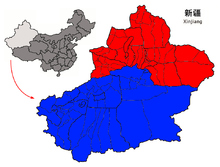East Turkestan
| East Turkestan | |||||||||

Dzungaria in red, the Tarim Basin in blue
|
|||||||||
| Chinese name | |||||||||
|---|---|---|---|---|---|---|---|---|---|
| Traditional Chinese | 東突厥斯坦 | ||||||||
| Simplified Chinese | 东突厥斯坦 | ||||||||
|
|||||||||
| Alternative Chinese name | |||||||||
| Traditional Chinese | 東土耳其斯坦 | ||||||||
| Simplified Chinese | 东土耳其斯坦 | ||||||||
|
|||||||||
| Uyghur name | |||||||||
| Uyghur |
شەرقىي تۈركىستان
|
||||||||
|
|||||||||
| Transcriptions | |
|---|---|
| Standard Mandarin | |
| Hanyu Pinyin | Dōng Tūjuésītǎn |
| Wade–Giles | Tung1 T'u1-chüeh2-szu1-t'an3 |
| Transcriptions | |
|---|---|
| Standard Mandarin | |
| Hanyu Pinyin | Dōng Tǔěrqísītǎn |
| Wade–Giles | Tung1 T'u3-erh3-ch'i2-szu1-t'an3 |
| Transcriptions | |
|---|---|
| Latin Yëziqi | Sherqiy Türkistan |
| Siril Yëziqi | Шәрқий Түркистан |
East Turkestan (Uyghur: شەرقىي تۈركىستان, Шәрқий Түркистан, Shərqiy Türkistan) also known as Eastern Turkistan, Chinese Turkestan, Uyghurstan, Uyghuristan is a political term with multiple meanings depending on context and usage. Historically, the term was invented by Russian Turkologists like Nikita Bichurin in the 19th century to replace the term Chinese Turkestan, which referred to the Tarim Basin in the southwestern part of Xinjiang province of the Qing dynasty. The medieval Persian toponym "Turkestan" and its derivatives were not used by the local population of the greater region, and China had its own name for an overlapping area since the Han Dynasty as Xiyu, with the parts controlled by China termed Xinjiang from the 18th century onward. The historical Uyghur name for the Tarim Basin is Altishahr, which means "six cities" in Uyghur.
Starting in the 20th century, Uyghur separatists and their supporters used East Turkestan (or "Uyghurstan") as an appellation for the whole of Xinjiang, or for a future independent state in present-day Xinjiang Uyghur Autonomous Region (presumably with Ürümqi as its capital). They reject the name of Xinjiang because of an allegedly Chinese perspective reflected in the name and prefer East Turkestan to emphasize connection to other westerly Turkic groups. However, even in nationalist writing, East Turkestan retained its older, more narrow geographical meaning. In China, the term has negative connotations because of its origins in European colonialism and present use by militant groups. The government of China actively discourages its use.
...
Wikipedia
